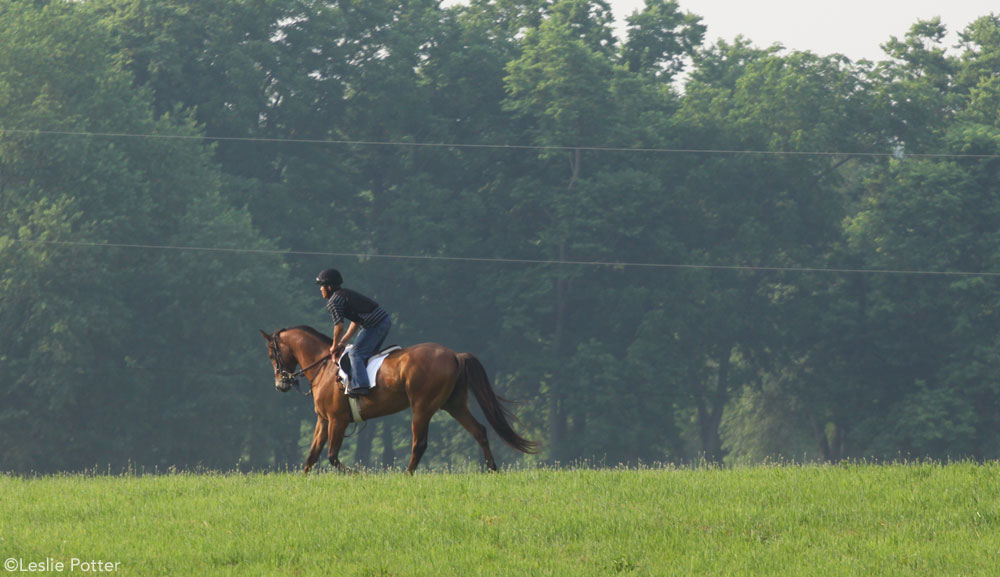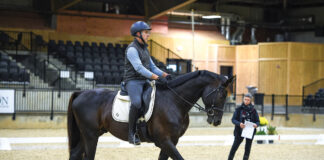
Once your horse is ready to get back to work, where should you begin? HI asked Chris Newton, DVM, of Rood & Riddle Equine Hospital in Lexington, Ky., for some advice. Newton specializes in equine sports medicine, field practice, reproduction and alternative therapies. Additionally, he competes in three-day eventing, show jumping and dressage while serving on multiple boards to help organize and further equestrian sport in Kentucky.
HI: What is the first step in reconditioning a horse after a layoff?
CN: Your route of return should be based on your horse’s previous experience and fitness level, and the goals you wish to accomplish during the upcoming season. If you want to compete early in the year, I don’t recommend a long layoff. Older horses (over 10 years of age for these purposes) tend to do worse than younger horses after an extended layoff. Every time your horse has to regain a base level of fitness, you increase the likelihood of injury. Maintaining a base level in older horses is important. For younger horses, a layoff can be beneficial for mental breaks and continued physical maturation.
HI: What should the first week’s schedule include?
CN: The general rule of thumb is that a horse maintains fitness for the first three weeks of a layoff. The old horseman’s saying is that for every day off, your horse needs a day of training to return to the prior level. At around the eighth week of a layoff, the horse will have lost significant condition, so you’ll have to reapproach basic fitness. The first focus should be foundation work, which requires long periods under tack with low-impact exercise, such as flatwork and hacking.
If you lay out a time-based conditioning plan and run through a set of time limits without paying attention to your horse’s fatigue level, you can injure him. I work up to getting a horse out for one to two hours a few times a week for very slow work, which is still muscularly intense, so I can feel where fatigue enters the picture for that individual horse. Then we back off.
The most difficult part of reconditioning is the tendons, ligaments and bones—those are most susceptible to injury. Muscles become more rapidly conditioned. The heart is a muscle that is constantly working, even during periods of rest, and is the most adaptable muscle to conditioning.
The last focus of your routine should be cardiovascular work. Horses will stay in aerobic conditioning while trotting. If you want to work on anaerobic training, then you can canter, but you need to do so slowly.
HI: When is it OK to add canter work and jumping to the conditioning schedule?
CN: You need to do six weeks of [long, slow] foundational work before pushing more on the cardiovascular system. If the horse has had more than two months off, I do 30 days under tack before jumping, and then jump once a week after that.
HI: When is a horse ready to go on a long trail ride (for example, four hours)?
CN: Non-competitive trail riders usually ride three to four days a week, so they need to have six to eight weeks of progressively more rigorous trail rides to get to that long ride. On that first long ride, most of it should be spent walking, and you can slowly add trot and canter work after you have taken your horse on more rides throughout the season.
HI: When can a rider start adding speed work (such as running barrels) to the program?
CN: Use your six- to eight-week foundational work to build up the base level of fitness before doing anything with speed. As soon as you add speed, you increase the load on each of your horse’s limbs. You’ve got to strengthen your horse’s ligaments, bones and muscles so they don’t fatigue under stress, since that is when he’ll end up with injuries.
If you’re doing speed work, start out with increasingly longer slow canter sets. The big mistake a lot of riders make when they think of “doing gallops” is to allow the horse to gallop in a long stride (which the horse likes to do)—this overloads the front end. If a horse becomes fatigued that way, there’s a significantly higher risk of injury to his tendons and ligaments. You need to allow your horse’s body to gain strength during slow work so he will not fatigue when you apply speed work.
Further Reading
Conditioning Horses with Hill Work
Spring Training
This article originally appeared in the May 2009 issue of Horse Illustrated magazine. Click here to subscribe!






I was starting to condition my Horse and this schedule is great info for me.
I was about to make some serious mistakes!!
Thank you for this timely article.!!